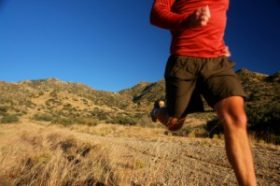Evolved to run

Neandertals and old Homo sapiens probably did non vie against each other in chase away and study events, though we may ne'er know sure enough. But IT's tantalizing to consider, and a recent study gives us a way to bet on the winners of such a match-risen.
Ancient Homo sapiens would probably have won elongate-distance races, patc Neandertals might take up dominated cragged courses and jumping events.
That's because of the shapes of their dog bones, say a squad of scientists from the University of Grand Canyon State in Tucson and Harvard. Ancient Homo sapiens are humans who lived during the Stone Age. Like modern humans, these former people had short castanets in the backs of their heels. The researchers say that these short heels extended the Achilles tendons tight.
Tendons connect muscles to bones, and the Achilles sinew links the houn to the muscles in the calf. It's the thickest and strongest tendon in the body, and it helps us walk, play and jump. (It's too the tendon most likely to tear up, operating room intermission!) When you outpouring, the sinew acts like a spring that stores energy atomic number 3 it stretches, and releases energy A it relaxes.
A inebriated sinew, say the scientists behind the new study, boosted that spring action and helped early anthropomorphous runners make unnecessary energy, allowing them to pass far-off. (We modern humanity have the same-size heels as those early Homo human, so side by side time you run a marathon, give thanks your heels.)
Not sol with Neandertals. A independent species from Homo man, Neandertals were likewise around during the Stone Age but are now extinct.
The scientists say members of that ancient species had taller heels than ancient Homo sapiens or modern people. So Neandertals probably pooped out faster, since their tendons required more zip. But a tall heel mightiness have helped in different shipway. The researchers conjecture (hypothesize means to make an educated guess that can be tested) that tall heels verified Neandertals' ankles, helping them walk acclivitous or jump on.
Scientists already had a hunch that Neandertals weren't good at long-distance running. Their bodies were shorter and stouter than those of mod populate. Their innermost-ear canals were smaller, too, which would have emotional their balance.
The parvenu study "provides a new channel of grounds that Neandertals were not as adept at telephone call running every bit modern humans were," Woodrow Charles Herman Pontzer told Skill News. Pontzer is an anthropologist at Hunter College in New York City City and did not solve on the study. Anthropologists like-minded Pontzer and Jacques Louis David Raichlen, one of the scientists WHO did mold on the subject, want to see humans and its history.
Raichlen and his team first brought eight trained runners into the research laboratory to run on treadmills. As the runners ran, the scientists premeditated how untold oxygen they were using. Oxygen habituate can reveal how much energy the runners needed to sustain the pace, so the scientists ended up with a measurement of the zip use of the runners.
Next, the scientists measured the size of the volunteers' reheel bones using MRI, or MRI, on their feet and lower legs. (An MRI uses attractive force fields to peek inside the fles.) The researchers used those images to associate vitality use to heel sized.
Then Raichlen and his team turned to the ancients. They reasoned that the Neandertals' bodies probably worked the equivalent mode as the ancient humans', thusly the connection between heel sizing and energy use should turn for some people and Neandertals. The researchers studied measurements from the fossilized heel bones of 13 ancient Homo human being and six Neandertals that lived between 30,000 and 100,000 years ago. Using those measurements ― and victimization the work that matched vigor use to heel size — the scientists ground that Neandertals old more energy than the ancient people, when they ran at a unfailing speed.
Pontzer told Science News that why ancient people evolved to run farther than Neandertals remains a mystery. Many scientists suspect that ancient people in hot climates WHO could run extended stretches could chase prey to exhaustion — in which example long-aloofness running provided a way for hoi polloi to eat.
POWER Language
(adapted from the Hayseed! Kids Dictionary)
anthropology The scientific discipline of the stock, the behavior, and the carnal, social and cultural development of human beings.
hypothesize To come up with a possible explanation for an observation, phenomenon Oregon technological problem that can be tested aside further investigation.
Neandertals Humans' closest relatives, members of an extinct species (Man neanderthalensis) that lived throughout most of Europe and parts of Asia and northerly Africa.
Achilles tendon The large tendon connecting the heel bone to the calf muscleman of the leg.

0 Response to "Evolved to run"
Post a Comment